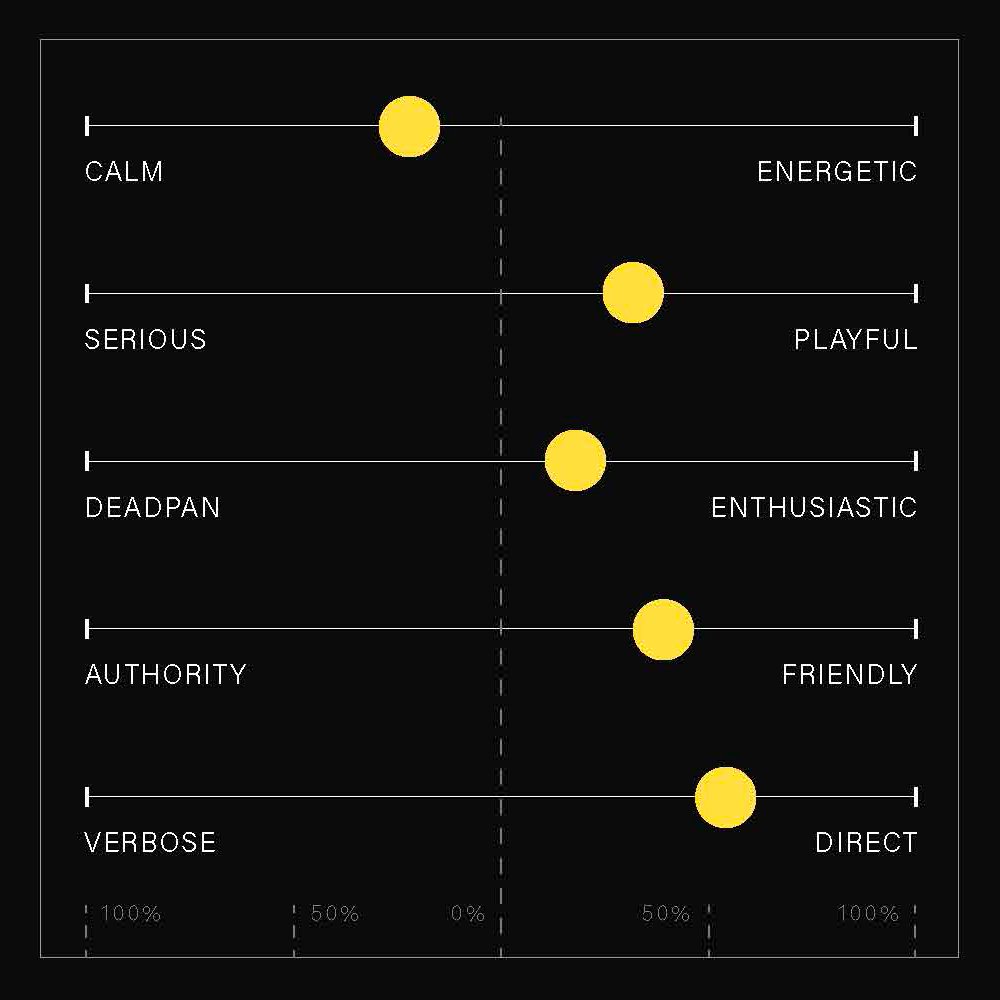Understanding Brand Tone of Voice
And its core components
Introduction
Brand tone of voice is the embodiment of a brand’s personality in written and verbal communication. In today’s highly competitive market, establishing a distinctive brand identity is essential for businesses to stand out. Beyond visual aesthetics and logos, one of the most powerful tools for creating a memorable brand is the tone of voice. A brand’s tone of voice encompasses the style, personality, and language it uses to communicate with its audience. Whether playful or professional, formal or informal, the tone of voice shapes how consumers perceive and engage with a brand.
In a survey conducted by Deloitte, roughly 80% of consumers stated that they trust a brand more when its communication delivers trustworthy and honest content – which underscores the importance of tone of voice and brand messaging. Whish is why we delve into the significance of brand tone of voice, its elements, and strategies.
According to a survey by Lucidpress, 77% of marketers believe that a strong brand tone of voice contributes to brand loyalty. So what are the fundamental elements that contribute to an effective tone of voice strategy?
Core elements
Personality
At the heart of every compelling tone of voice lies a well-defined personality. Just as humans exhibit diverse personalities, brands too can project characteristics that resonate with their audience. Whether it’s a playful demeanour, a sense of authority, or a touch of sophistication, the chosen personality should align with the brand’s values and appeal to its target demographic. By imbuing the brand with a distinct personality, businesses can humanize their communication and foster relatable connections with consumers.
Vocabulary and language
The choice of words and language style plays a pivotal role in shaping a brand’s tone of voice. From formal and technical terminology to colloquial expressions and slang, the vocabulary employed should reflect the brand’s identity and cater to the preferences of its audience. Additionally, considerations such as simplicity, clarity, and cultural sensitivity are paramount in ensuring effective communication. By tailoring the vocabulary and language to suit the brand’s persona and audience demographics, businesses can enhance engagement and resonance with their target market.
Tone
The tone encapsulates the emotional essence of the brand’s communication. Whether it’s conveying empathy, humor, authority, or excitement, the tone sets the mood and evokes specific emotions in the audience. A brand’s tone should be consistent across various touchpoints, reinforcing its personality and values while adapting to the context of each communication channel. By striking the right tone, brands can elicit desired emotional responses from consumers, fostering deeper connections and building brand affinity.
Consistency
Consistency is the cornerstone of effective brand communication. A cohesive tone of voice ensures that every interaction with the brand reinforces its identity and values, fostering familiarity and trust among consumers. Whether it’s through marketing campaigns, social media posts, customer support interactions, or product messaging, maintaining consistency in tone reinforces brand recall and strengthens brand perception. By adhering to established tone of voice guidelines, businesses can cultivate a unified brand identity and streamline communication across all channels.
Authenticity
Authenticity lies at the heart of compelling brand communication. A genuine tone of voice resonates with consumers on a deeper level, fostering trust and loyalty. Authenticity entails aligning the brand’s tone with its values, being transparent in communication, and avoiding artificial or contrived messaging. By staying true to its identity and voice, a brand can build genuine connections with its audience, driving engagement and advocacy.
Mastering the key elements of tone of voice is essential for creating meaningful connections and shaping brand perception. By defining a distinctive personality, carefully selecting vocabulary and language, striking the right tone, maintaining consistency, and prioritizing authenticity, businesses can craft a compelling tone of voice that resonates with their audience and sets them apart in a crowded marketplace. Establishing the core elements is just as important as developing efficient strategies for a cohesive brand tone of voice.
Strategies
Define your brand identity
Before crafting your tone of voice, it’s imperative to have a clear understanding of your brand’s identity, values, and mission. Conduct thorough research to identify your target audience, competitors, and market positioning. Define your brand’s personality traits, such as friendly, professional, authoritative, or innovative. These insights will serve as the foundation for shaping your tone of voice.
Conduct audience research
Understanding your target audience’s demographics, preferences, behaviors, and communication styles is essential for tailoring your tone of voice to resonate with them effectively. Use surveys, focus groups, social media analytics, and customer feedback to gain valuable insights into your audience’s preferences and expectations. Adapt your tone of voice to align with their preferences while remaining authentic to your brand identity.
Develop brand voice guidelines
Create comprehensive brand voice guidelines that outline the key elements of your tone of voice, including vocabulary, language style, tone, and examples of communication scenarios. Define guidelines for different communication channels, such as social media, website content, advertising, and customer support. Ensure that all stakeholders, including marketing teams, copywriters, and external partners, are familiar with and adhere to these guidelines.
Align your tone of voice with brand values and objectives
Your tone of voice should align seamlessly with your brand’s values, objectives, and positioning in the market. Ensure that every communication reflects your brand’s ethos and resonates with your target audience’s aspirations and beliefs. Consistency in messaging reinforces your brand’s authenticity and builds trust with consumers.
Foster collaboration and feedback
Developing a cohesive tone of voice is a collaborative effort that involves input from various stakeholders within your organization. Encourage cross-functional collaboration between marketing, branding, communications, and customer service teams to ensure alignment and consistency in messaging. Solicit feedback from team members and conduct regular reviews to refine and evolve your tone of voice strategy based on performance and audience response.
Adapt to context and audience needs
While consistency is essential, it’s also important to adapt your tone of voice to different communication contexts, audience segments, and cultural nuances. Tailor your messaging to suit the specific needs, preferences, and sensitivities of different audience groups while maintaining a consistent brand identity. Flexibility in tone allows your brand to remain relevant and engaging across diverse demographics and markets.
Test and iterate
Continuous testing and iteration are key to refining and optimizing your brand tone of voice over time. Monitor audience engagement, sentiment, and response to different messaging approaches across various channels. Analyze metrics such as click-through rates, conversion rates, and social media engagement to gauge the effectiveness of your tone of voice strategy. Use A/B testing and experimentation to identify the most resonant messaging styles and refine your approach accordingly.
Crafting a cohesive brand tone of voice requires a strategic approach that aligns with your brand’s identity, values, and audience preferences. By defining your brand identity, conducting audience research, developing comprehensive guidelines, and fostering collaboration, you can create a tone of voice that resonates with your audience and enhances brand perception. Adaptability, continuous testing, and iteration are essential for refining your tone of voice strategy and maintaining relevance in an ever-evolving marketplace. By implementing these strategies effectively, businesses can establish a distinct and impactful brand voice that resonates with consumers and drives long-term brand loyalty and advocacy.
Examples
Now that we’ve established the key elements of Tone of Voice and key strategies to successfully deliver it, It’s worth looking and few brand who carry their tone and messaging with true grace.
Innocent Drinks
Innocent Drinks, known for its playful and friendly tone of voice, effectively engages its audience through witty and conversational communication across its product packaging, social media channels, and marketing campaigns.
Airbnb
Airbnb’s tone of voice is characterized by warmth, inclusivity, and authenticity, reflecting its commitment to creating meaningful travel experiences for its diverse global community. Through consistent use of conversational language and storytelling, Airbnb establishes an emotional connection with its audience, inspiring trust and loyalty.
Nike
Nike’s tone of voice is bold, inspirational, and empowering, reflecting its brand ethos of athleticism, determination, and innovation. Nike’s messaging resonates with athletes of all levels, encouraging them to push their limits and strive for excellence. Through powerful storytelling and motivational language, Nike reinforces its position as a leading sports brand and cultural icon.
Captivate your audience
Conclusion: In the digital age, where brands vie for consumers’ attention amidst a constant influx of information, the tone of voice emerges as a powerful tool for building meaningful relationships and fostering brand loyalty. By understanding the key elements, benefits, and strategies for developing a cohesive tone of voice, businesses can effectively communicate their brand’s personality, values, and message to captivate audiences and differentiate themselves in the marketplace. As brands continue to evolve and adapt to changing consumer preferences, the importance of a distinct and authentic tone of voice in shaping brand identity and perception remains ever relevant.

